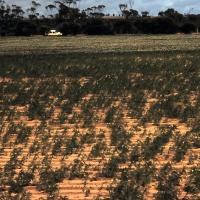Diagnosing allelopathy in narrow-leafed lupins
Allellopathy is a disorder of germinating plants caused by plant phytotoxins.
What to look for
- Poor germination and spindly seedlings in patches, rows or scattered plants where the plant is in contact with plant residues.
- Severity may vary with soil type or amount of plant residues.
Paddock
- Seeds germinate but fail to reach the surface, or appear later with yellow cotyledons and new growth.
- The hypocotyl is thickened and bent, often to the extent that the plant fails to emerge or emerges then re-enters the soil.
- Roots are grossly distorted and reduced.
- Affected seedlings usually slowly die, leaving an overall reduction in plant density
Plant
What else could it be
| Condition | Similarities | Differences |
|---|---|---|
| Diagnosing poor quality seed in narrow-leafed lupins | Reduced and staggered germination. Malformed seedlings | Allelopathy affected plants remain pale, distorted and stunted |
| Diagnosing seedbed constraints in narrow-leafed lupins and field peas | Reduced and staggered germination | The problem is more likely to vary between rows, and with changes in soil or landscape position. Established plants grow normally. |
| Diagnosing water repellence | Reduced and staggered germination | The problem is more likely to vary between rows, and with changes in soil type. |
| Diagnosing waterlogging in narrow-leafed lupins and field peas | Reduced and staggered germination | Waterlogged and saline areas are often clearly defined, and the problem is ongoing. |
Where does it occur?
- Phytotoxicity most often results from toxins leaching into the soil from dead or dying plants in the following situations:
- Allelopathy from summer weeds such as goosefoot (Chenopodium pumilio).
- Where previous season's crop or pasture residues are left in contact with the seed during seeding.
- Where crops are sown into weedy seedbeds sprayed with a herbicide before the weeds have died.
- Toxicity tends to be worse where crops are sown in a moist drying seedbed, where there is insufficient rainfall to leach toxins through the soil profile, and in cold, cloudy weather.
- Toxins that cause allelopathy predispose plants to fungal root rot.
- Lupins have been affected in a silo by toxins released by green wild radish seed that was harvested with the seed.
Management strategies

Weed and pasture control
- There is no treatment for affected plants.
- Allelopathy can be avoided by minimising summer weed growth and plant residue contact with the seed at sowing.
Where to go for expert help
Page last updated: Tuesday, 20 January 2015 - 10:51am





